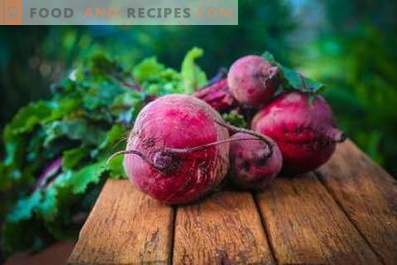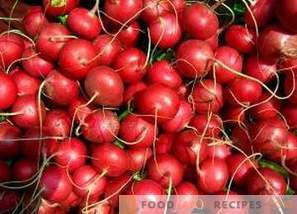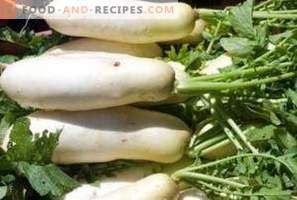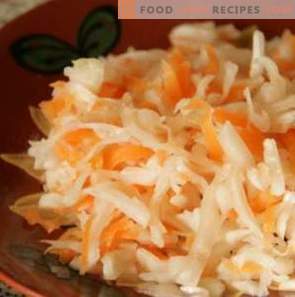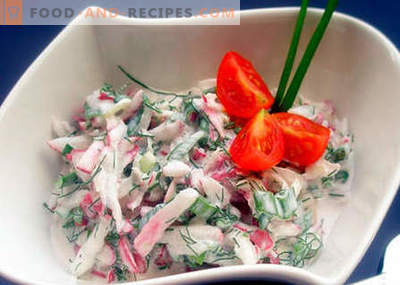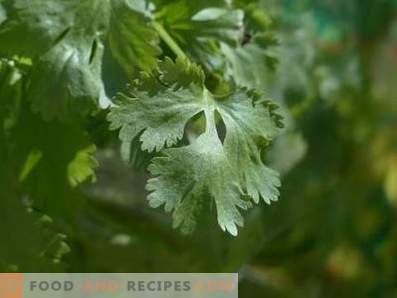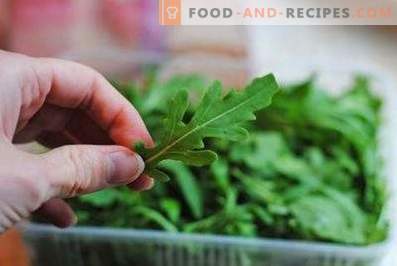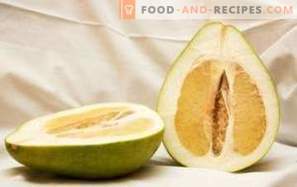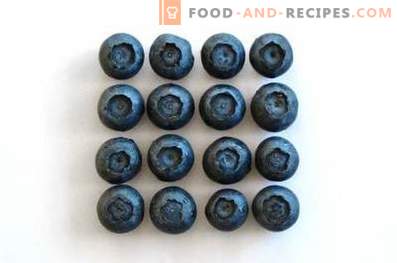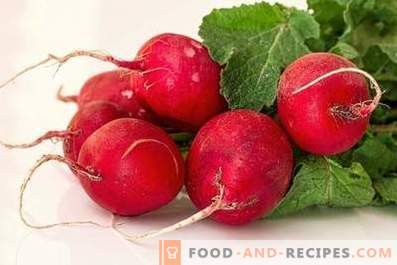
Radish is a vegetable crop belonging to the Cabbage family (genus Radish). The land of the plant is considered the territory of the Mediterranean: according to the results of historical research, dishes from its root crops were an important part of the diet of the ancient peoples of Greece, Japan, Egypt, China and Rome.
In Europe, radishes began to cultivate in the XVI century. Dishes prepared on its basis, the first to appreciate the French chefs and gourmets. The radish came to Russia only at the end of the 17th century: the seeds of this plant were brought from Amsterdam by Peter I. Today this unpretentious and cold-resistant culture is grown in most countries of the world.
Radish is a herbaceous plant with oblong, strongly dissected green leaves collected in a small rosette. The flowering stem of the crop can reach a length of 95-100 cm. Yellow or white radish flowers are collected in racemes. The fruits of the plant are small cylindrical or spindle-shaped pods with light brown egg-shaped seeds.
Elongated conical or spherical root vegetables of radish, having a spicy, slightly pungent taste and a neutral smell, are covered with the finest white, pale pink, yellow, red or purple skin. Their mass can vary from 6 to 450 g.
Most often, radishes are eaten fresh, after having removed a thin peel from it and cut it into thin slices. In addition, the roots and tops of this plant are used to make soups and healthy vegetable salads.
Nutritional value of radish and vitamins in its composition
Nutritional value radish:
- 1, 192 g of proteins;
- 0, 093 g of fat;
- 3, 329 g of carbohydrates;
- 3, 04 g disaccharides, monosaccharides;
- 0, 289 g of dextrins, starch;
- 1, 588 g of dietary fiber;
- 92, 887 g of water;
- 0, 597 g of ash;
- 0, 091 g of organic acids.
Vitamins in radish:
- 0, 009 mg of thiamine (B1);
- 0, 299 mg of niacin equivalent (PP);
- 5, 981 µg of folate (B9);
- 0, 038 mg of riboflavin (B2);
- 24, 773 mg of ascorbic acid (C);
- 0, 178 mg of pantothenic acid (B5);
- 0.098 mg tocopherol equivalent (E);
- 0.097 mg of pyridoxine (B6).
Calorie radish
The energy value of raw radish is 16, 112 kcal (per 100 g weight portion).
Useful items in radish
Macroelements in the composition of radish (in 100 g):
- 254, 667 mg of potassium;
- 43, 118 mg of phosphorus;
- 38, 714 mg of calcium;
- 43, 688 mg of chlorine;
- 12, 883 mg of magnesium;
- 9, 783 mg of sodium.
Trace elements in radish (per 100 g):
- 99, 724 μg of boron;
- 22, 966 mcg of lithium;
- 7,882 mcg of iodine;
- 29, 812 μg of fluorine;
- 0, 193 mg of zinc;
- 149, 446 μg of copper;
- 184, 722 mcg of vanadium;
- 2, 816 mcg of cobalt;
- 13, 793 μg of nickel;
- 0, 142 mg of manganese;
- 11, 012 mcg of chromium;
- 0, 961 mg of iron.
Useful properties of radish
- Radishes are a root crop with low energy value. Salads and soups cooked on the basis of this vegetable, you can diversify the diet menu of people seeking to lose weight.
- Radish contains a whole complex of organic acids, minerals and vitamins that help strengthen the immune system.
- Antioxidant compounds present in the composition of radish, significantly reduce the risk of tumor neoplasms in the tissues of the chest and intestines.
- Radishes are a powerful natural antibiotic. Phytoncides found in the pulp of this root, destroy harmful microflora in the oral cavity and in the gastrointestinal tract, help the body to resist most seasonal infections.
- Radishes are a rich source of fiber. Inclusion in the diet of dishes prepared on its basis contributes to the removal of toxins, accumulating in the body, excess cholesterol and toxins, activates the digestive system, reduces the risk of constipation.
- Radish is a natural antidepressant. The composition of this root includes compounds that eliminate malfunctions of the nervous system, reduce the risks of neurosis and depression, and neutralize the harmful effects of stress on the body.
- Radish contains a whole complex of compounds that contribute to blood thinning. Regular consumption of salads and soups prepared from this root, reduces the likelihood of cardiac malfunctions.
- Regular inclusion in the diet of radish helps stabilize the level of sugars in the blood, reduce the risk of developing and progression of diabetes.
- The B complex of vitamins present in the pulp of radish activates metabolic processes.
- Radish is rich in substances with diuretic and choleretic action. Dishes from it are useful for people suffering from diseases of the urinary system, edema, diseases of the gallbladder.
- Radish contains mustard oil, which has strong antiseptic properties. In folk medicine, the juice squeezed from the pulp of these root crops, is used for the treatment of small wounds.
- Regular consumption of radish reduces the risk of caries, gingivitis, stomatitis and other dental diseases. Traditional healers recommend applying fresh radish slices to an abscess with flux (such actions help ease pain, slow down the development of the pathological process).
- Radish juice is used to make lotions that relieve pain in bruises, radiculitis, joint diseases, sprains, rheumatism.
- Concentrated decoction of radish root crops is used as an expectorant.
- Radishes contain substances that can dissolve small stones in the kidneys and in the urinary tract.
- Radish sap is taken orally to relieve the unpleasant symptoms of gout. Daily dose - 55-70 g.
- Radish pulp, grated on a fine grater and combined with prune, pounded in a mortar, is a proven folk remedy for alcoholism. In order to get rid of the pathological craving for alcohol, it is enough to eat 10 g of the mixture prepared according to the above recipe daily.
- Radish juice is an effective remedy for migraine. With the appearance of headaches, the liquid is applied to the nose, temples and rubbed into the skin with soft massaging movements.
- In cosmetology, radishes are used to make moisturizing and rejuvenating facial masks. Several large root vegetables are ground on a fine grater and put gruel on the skin. After 10-13 minutes, the mask is washed off and put on the face moisturizer.
- Radish is used to prepare lotion designed to care for dry, prone to irritation and flaky skin. Fresh juice of root vegetables (2 parts) is diluted with boiled water (1 part) and infused in the refrigerator for a day. The tool is applied to a cotton pad and wipe their skin in the morning and immediately before bedtime.
Useful properties of radish topper
- A decoction of radish tops is taken orally for the prevention of beriberi.
- Radish leaves - an effective remedy for foot fungus. Warm socks with powder prepared from dried tops of this plant are put on sore feet for 6-7 hours. The procedure is repeated every day until the complete disappearance of the symptoms of the disease.
- Radish tops are used to prevent rickets in children. The leaves of the plant (9 pcs.) Cut with a knife and mixed with cottage cheese (100 g). The mixture is dressed with sour cream (20-25 g). Dish daily include in the diet of the child.
- Concentrated decoction of radish leaves is used to treat chronic constipation. Drink liquid for three days after each meal. Single portion of funds - 150 ml.
Damage to radish and contraindications to its use
- The main contraindication to eating radish for food is individual intolerance. In addition, dishes from this root and its tops are contraindicated for people suffering from pancreatitis, gastric or duodenal ulcer, colitis, gastritis, enterocolitis, thyroid diseases.
- People who have recently had a heart attack, it is advisable to temporarily abandon the consumption of radish. Mustard oil, present in the composition of this root, can provoke a repetition of the attack.
- Abuse of radish can lead to irritation of the epithelial tissues of the gastrointestinal tract and the appearance of pain in the stomach. Nutritionists recommend limiting the consumption of this vegetable 170-220 grams per week and do not eat meals based on it on an empty stomach.
- Pediatricians do not recommend including radishes in the diet of children under three years of age.
